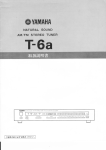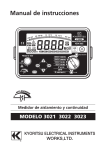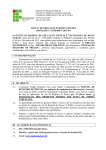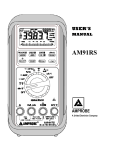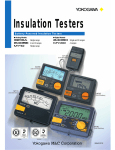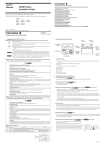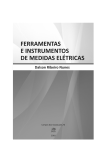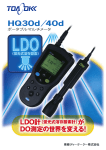Download Manta MG1000 Instruction manual
Transcript
No.0436-002AB 1-3 Overload protection When pressed for more than 2 seconds, continuous test voltage is output and indication appears. To release the lock, press the LOCK or MEASURE button, the test voltage output is stopped, the circuit under test is discharged automatically, and the last displayed value appears on the display together with the indication. 40 Ω measurement function: When pressed for more than 2 seconds, indication appears and the tester continues measuring. To release the lock, press the LOCK or MEASURE button. The measurement is stopped and the last displayed value appears on the display together with the indication. The maximum rated input value and overload protection have been defined for the input terminals of each function as shown below. MG1000/MG500/MG125 INSULATION RESISTANCE TESTER INSTRUCTIONS SANWA ELECTRIC INSTRUMENT CO., LTD. Dempa Bldg, 4-4 Sotokanda2-Chome Chiyoda-ku, Tokyo, Japan ②07.08獗 [1] SAFETY PRECAUTIONS Before use, read the following safety precautions. Thank you for purchasing the Sanwa MG1000/MG500/MG125 digital insulation resistance tester. Before use, please read this manual thoroughly to ensure correct and safe use. Keep this Instruction Manual together with the product. Be sure to read the information under “ WARNING” that is intended to prevent personal injury such as burn and electric shock and other serious accidents. 1-1 Explanation of Warning Symbols Function MΩ V 4000 Ω 40 Ω Max. Rated Input Overload Protection MΩ range: Within 120% of the rated measuring voltage. 600Vrms 780Vrms 600Vrms Fuse, 0.5 A/600 V Overvoltage measurement categories Overvoltage measurement category I (CAT. I ) : Line on the secondary side on the inside of equipment via a transformer, etc. from the receptacle. Overvoltage measurement category II (CAT. II ) : Line on the primary side of equipment with power cord to be connected to the receptacle. Overvoltage measurement category III (CAT. III ) : Line from the primary side or branch of equipment which directly takes in electricity from a distribution board to the receptacle. Overvoltage measurement category IV (CAT. IV ) : Line from the service conductor to the distribution board. LIGHT button Turns backlight on/off. The backlight goes off automatically after 10 seconds. 澀 0Ω ADJ button Zero Ohm adjustment for 40 Ω measurement function or when selecting the maximum MΩ measurement function. 潯 Power/function switch Turns the tester ON/OFF or to select a function. The body cover cannot be closed unless this switch is set to the OFF position. 2-1 Applications 潛 RATING VOLTAGE indicator Lights up in MΩ measurement function. It blinks when the test voltage drops below rated value. This instrument is a DC insulation resistance tester for use in measurement of insulation resistance of a power line and power equipment within the range of 600 V under CAT III. 濳 ALARM indicator Lights up when the input is about 30 V AC/DC or more. It can be used as the live circuit detection, etc. 潭 Test lead storage space Space to store the test leads and alligator clips. 2-2 Features 澂 Strap hook To attach a strap. [2] APPLICATIONS AND FEATURES • Safety design in compliance with IEC61010-1 • MΩ function with automatic live circuit detection (>30V AC/DC) • Easy-to-read display showing large figures and log bar graph for reading in an analog feeling • Automatic hold function to hold the last displayed value to look it safely after measurement • LCD panel with backlight function • Auto discharge function • 40.00 Ω measurement function ( ≧ 200 mA short circuit current) [3] NAMES AND FUNCTIONS OF COMPONENT UNITS 1-2 Warning Messages for Safe Use Instrument body LCD panel 潦 CAUTION 1. The measuring terminals output high voltages during insulation resistance measurement. To prevent damaging the tester and parts (including chips) with low or unknown withstanding voltages, connected to the measured electrical path (circuit), it is recommended to disconnect them from the electrical path before measurement. This care is specially important with computer equipment. 2. The rated measuring voltage used in insulation resistance measurement should be as close as possible to the operating voltage of the circuitry to measure. For example, when measuring an electrical path of 100 V, it is recommended to use a tester with a rated measuring voltage of 125 V. 澳 澣 澡 澤 濂 澑 澎 潘 濆 潺 潯 Plug Strap (ST-50) 潸 澁 Description 漓 EARTH/COM terminal Grounding/COM terminal for connecting the black alligator clip. 滷 LINE/+ terminal Line/+ terminal for connecting the red test lead. 澆 LCD panel Displays the value, function name or voltage output status. MEASURE button MΩ measurement function: • Press and hold the button to output the test voltage. When the button is released, the test voltage output is stopped, the circuit under test is discharged automatically, and the last displayed value appears on the display together with the indication. • When the button is pressed during continuous test voltage generation using the LOCK button, the test voltage is stopped, the last displayed value is held, and the circuit under test is discharged automatically. 40 Ω measurement function: • Press and hold the button to start measuring. When the button is released, the test voltage output is stopped and the last displayed value is held appears on the display together with the indication. • When the button is pressed during continuous measurement using the LOCK button, the measurement is stopped and the last displayed value is held. 潺 Nominal test voltage & Measurement Range Center scale 250V 4.000MΩ/40.00MΩ 400.0MΩ/4000MΩ 10MΩ Measurement Range 1st effective measurement range Accuracy 0.5∼20.00MΩ ±(3%rdg+4dgt) 0∼0.49MΩ 2nd effective measurement range 20.01∼4000MΩ ±(5%rdg+5dgt) 1st effective 500V measurement range 1.000∼500MΩ ±(3%rdg+4dgt) 4.000MΩ/40.00MΩ 100MΩ 0∼0.999MΩ 2nd effective 400.0MΩ/4000MΩ measurement range 501∼4000MΩ ±(5%rdg+5dgt) 1st effective 1000V measurement range 2.000∼1000MΩ ±(3%rdg+4dgt) 4.000MΩ/40.00MΩ 100MΩ 0∼1.999MΩ 2nd effective 400.0MΩ/4000MΩ measurement range 1001∼4000MΩ ±(5%rdg+5dgt) Open circuit voltage 1 to 1.3 times of nominal test voltage AC voltage operation indicator Rated measurement current 1.0-1.2 mA (250 V @0.25 MΩ, 500 V @0.5 MΩ, 1000 V @1 MΩ) Negative value indicator Short-circuit current 2mA or less Live circuit detection 澑 MΩ measurement function: Lights up when the tester outputs test voltage. Lights up when the object to be measured is charged about 30 V or more. V measurement function: Lights up when the input is 600 Vrms or more. At ≧ 30V AC/DC or more, inhibits test, buzzer sounds and ALARM indicator lights up. Model:MG500 Nominal test voltage & Measurement Range Center scale 125V 400.0kΩ 4.000MΩ/40.00MΩ 400.0MΩ/4000MΩ 10MΩ Measurement Range Accuracy 濂 DC voltage operation indicator. 潦 Auto Power Save mode indicator The tester enters “power save mode” automatically if it has not been operated for about 30 minutes. The tester come out of “power save mode” when power/function switch is turned to OFF once and set to the required function again. To cancel Auto Power Save function, turn the power/function switch from OFF position to any desired function while holding the LIGHT button pressed. *A small electric current from power supply is present in Auto Power Save mode. Be sure to set the power/function switch to “OFF” after measurement. 1st effective 500V ±(3%rdg+4dgt) 1∼500MΩ measurement range 400.0kΩ 100MΩ 4.000MΩ/40.00MΩ 0∼0.999MΩ 2nd effective 400.0MΩ/4000MΩ measurement range 501∼4000MΩ ±(5%rdg+5dgt) Open circuit voltage 1 to 1.3 times of nominal test voltage Data Hold indicator Rated measurement current 1.0-1.2 mA (125 V @0.125 MΩ, 250 V @0.25 MΩ, 500 V @0.5 MΩ) Test lock (continuous test voltage output) indicator Short-circuit current 2mA or less 0 Ω adjustment indicator Live circuit detection 澤 Low battery warning indicator: Appears when the internal batteries are exhausted (to about 7.2 V or less). When the indicator appears or blinks, replace the batteries with new ones. Model:MG125 澹 Unit indicators. 濆 Logarithmic bargraph Disabled in the 40 Ω measurement function 澳 澣 澡 澀 Name 4-2-1 Insulation resistance measurement functions (kΩ , MΩ) Model:MG1000 澎 Test pin Finger guard Temperature 23 ± 5°C, humidity 45% to 75% RH. rdg: Reading. dgt: Digits 潘 潭 潼 濳 潛 Test lead (TL-112) 4-2 Measurement Range and Accuracy Numeral and decimal point 澹 澆 MG125, MG500 : Approx. 5 hours MG1000 : Approx. 2 hours 30 minutes IEC61010-1 CAT.III 600V, IEC61557-1/2/4, IEC61326 (EMC), IEC60529-IP54, IEC61010-031 (TL-112) Dimensions 170 (L) X 142 (W) X 57 (H) Weight Approx. 600g (battery included) Power consumption Apporox. 7mA at V function Accessories Battery (built-in), test leads (TL-112), Strap (ST-50), instruction manual Optional accessories Alligator clip CL-16 潼 澂 澂 漓 滷 WARNING 1. Never use the tester on a high-power or high-voltage line. 2. Voltages above 70 VDC or 33 Vrms AC (46.7 V peak) are hazardous to human body. Never touch them. 3. Disconnect circuit power before testing insulation resistance. 4. Use caution with the high voltages output when performing insulation resistance measurement to avoid electric shock. 5. To prevent electric shock, always discharge capacitive circuits after the insulation resistance measurement. 6. Never input signals exceeding the maximum rated input value (see 1-3). 7. Never use the tester for measuring voltages of lines connected to equipment (e.g. motors) that generates induced or surge voltage since it may exceed the maximum allowable overload input. 8. Never use the tester if the tester or test leads are damaged or broken. 9. Never use the tester with the rear-case or battery lid removed. 10. When using the test leads, keep your fingers behind the finger guards. 11. During measurement, do not change the function or range nor replace the plugs. 12. Never use the tester when it is wet or with wet hands. 13. Be sure to use the fuse of the specified rating and specification. 14. Do not touch the metallic part of the alligator clip connected to grounding side as voltage is present. 15. When connecting the alligator clip, connect it to the grounding side of the object to be measured first. When disconnecting it, disconnect the test lead from the line first, and then disconnect the teat lead from the grounding side of the measured object. 16. Never attempt repair or modification, except for battery and fuse replacement. 17. Inspect the tester at least once a year. 18. This tester is for indoor use only. 19. Never use the tester near equipment that generates strong electromagnetic waves or is charged. LOCK button 澁 The meaning of the symbols used in this manual and attached to the product is as follows: : Very important instructions for safe use • The warning messages are intended to prevent accidents to operating personnel such as burn and electric shock. • The caution messages are intended to prevent incorrect handling and measurement which may damage the product. : Dangerous voltages : Ground. : DC. : AC. : Fuse. : Double or enhanced insulation. WARNING The following instructions are intended to prevent personal injury such as burn and electric shock. Be sure to follow them when using the tester: 潸 Time of measurement Safety / EMC [4] SPECIFICATIONS 4-1 General Specifications AC Sensing LCD Sampling rate Range selection Over-range indication Average value 4200 count with log bar graph Approx. 2 times / sec. Auto only Range up: approx. 4200 count or over, Range down: approx. 380 count or below “OL” indication on LCD V function: 780V or over MΩ, 4000Ω, 40Ω function: Approx. 4200 count or over Polarity indication “ − ” indication only when negative input Low battery indication “ ” lights or flickers at about 7.7V-7.2V or below Environmental condition Altitude 2000m or below, pollution degree II Operating temperature / 0°C to 40°C and maximum relative humidity 90% humidity (No condensation) Storage temperature / -10°C ~ 50°C, 70%RH or below (with battery removed). humidity Power supply R6 1.5V x 6 pcs (MG125, MG500) ; LR6 1.5V x 6 pcs (MG1000) 1st effective measurement range 20.0kΩ∼10.00MΩ ±(3%rdg+4dgt) 0∼19.9kΩ 2nd effective measurement range 10.01∼4000MΩ ±(5%rdg+5dgt) 1st effective 250V measurement range 50.0kΩ∼20.00MΩ ±(3%rdg+4dgt) 400.0kΩ 100MΩ 4.000MΩ/40.00MΩ 0∼49.9kΩ 2nd effective 400.0MΩ/4000MΩ measurement range 20.01∼4000MΩ ±(5%rdg+5dgt) At ≧ 30V AC/DC or more, inhibits test, buzzer sounds and ALARM indicator lights up. Nominal test voltage & Measurement Range Center scale 25V 400.0kΩ/4.000MΩ 40.00MΩ/400.0MΩ 1MΩ 1st effective measurement range 10.0kΩ∼5.00MΩ ±(3%rdg+4dgt) 0∼9.9kΩ 2nd effective measurement range 5.01∼400.0MΩ ±(5%rdg+5dgt) 50V 400.0kΩ/4.000MΩ 40.00MΩ/400.0MΩ 1MΩ 1st effective measurement range 10.0kΩ∼5.00MΩ ±(3%rdg+4dgt) 0∼9.9kΩ 2nd effective measurement range 5.01∼400.0MΩ ±(5%rdg+5dgt) Measurement Range Accuracy 1st effective measurement range 20.0kΩ∼10.00MΩ ±(3%rdg+4dgt) 0∼19.9kΩ 2nd effective measurement range 10.01∼400.0MΩ ±(5%rdg+5dgt) Open circuit voltage 1 to 1.3 times of nominal test voltage 125V 400.0kΩ/4.000MΩ 40.00MΩ/400.0MΩ 1MΩ Rated measurement current 1.0-1.2 mA (25V@ 0.025MΩ, [email protected]Ω, [email protected]Ω) Short-circuit current 2mA or less Live circuit detection At ≧ 30V AC/DC or more, inhibits test, buzzer sounds and ALARM indicator lights up. Note When the displayed value is 2000 MΩ or more, the lowermost digit is fixed at 0. No.0436-002AB 4-2-2 Voltage measurement function (AC/DCV) Range Resolution AC/DC 600V 1V Input Resistance Max. Overload Protection Accuracy ±(3%rdg+2dgt) 9MΩ 780Vrms Note ACV and DCV are automatically detected. Sensitivity: 2 V or higher. AC frequency bandwidth: 45-400 Hz The ALAMP indicator lights up when the input is ≧ 30 V AC/DC. “ ” appears and buzzer sounds if the input is ≧ 600 Vrms. Maximum display value: 780 V. 5-2 Start-up inspection Inspection/ Check Appearance Internal batteries Test leads 4-2-3 4000 Ω measurement function / Continuity buzzer ( Ω ) Range 4000 Ω Resolution 1Ω Accuracy Input Resistance Max. Overload Protection ±(3%rdg+3dgt) ≥3V 600Vrms Note A buzzer sounds below about 40 Ω. A buzzer sounds and the ALARM indicator lights up when the input is ≧ 30 V AC/DC. Fuse Method Check if the instrument body appears damaged. Check if appears on the top right of the LCD. If appears or blinking, replace all batteries with new ones (see section 6-4-1). Select the 4000 Ω measurement function, short the test lead and alligator clip, and ensure the displayed value is no more than 1 Ω. If “OL” is displayed, replace the test leads as they may be damaged. Select the 40 Ω measurement function, short the test lead and alligator clip, and ensure the displayed value is no more than 0.05 Ω. If “OL” is displayed, replace the fuse as it may be damaged (see section 6-4-2). 5-3 Voltage measurement method 5-5 4000 Ω Resistance measurement / Continuity check method 5-5-1 Buttons used in measurement No button is used. 5-5-2 Measurement method 1. Set the power/function switch to “4000 Ω.” 2. Connect the test lead to the object to be measured. 3. Read the displayed value. 6-4 Battery / Fuse replacement Battery when the meter is shipped: A battery for monitoring has been installed prior to shipment from the factory. It may be discharged before the expiration of the described battery life. *The battery for monitoring is a battery used to check the functions and performance of the product. WARNING 1. If the rear case is removed with an input being applied to the measuring terminals, you may suffer electric shock. Before starting replacement, always make sure no input is being applied and the function switch is OFF. 2. Be sure to use the fuse of the specified rating and specification. Never use a substitute nor short the fuse terminals. 6-4-1 Battery replacement: R6 1.5V x 6pcs (MG125, MG500) ; LR6 1.5V x 6pcs (MG1000) 5-6 40 Ω measurement method 5-6-1 Buttons used in measurement Measurement: MEASURE button and 0Ω ADJ button. Continuous measurement: LOCK button, 0Ω ADJ and MEASURE button. 4-2-4 40 Ω measurement function ( Ω ) Display Range Measurement range Accuracy Resolution Open Circuit voltage Short-circuit current Protection Note 1. An oscillation tone may be heard during measurement, but this is not malfunction. 2. The automatically held value is retained until the start of the next measurement or the tester enters APS mode. The held value is released and the new measurement value is displayed when the next measurement is started. 3. If a measuring point of certain equipment for insulation resistance measurement is unknown, contact the manufacturer of that equipment to ensure correct measurement. Note ACV and DCV are automatically detected. 40.00 Ω 0.01 Ω to 40.00 Ω ±(3% + 10 dgt) (after 0 Ω ADJ) 0.01 Ω 6V (typical value) 200 mA minimum (≤ 2.0 Ω) Fuse (0.5 A/600 V) Grounding Line side side (LINE) (EARTH) Note: Use caution with battery polarity when replacing batteries. Buttons used 6-4-2 Fuse replacement Fuse: Part No. F1202, Ø6 X 30 mm, 0.5 A/600 V, breaking capacity 20 kA. Spare fuse (optionally available) Red indicator ON 5-4 Insulation resistance measurement method Note The bargraph display is disabled. [5] MEASURING PROCEDURE WARNING 1. Be sure to conduct the start-up inspection described in section 5-2 below. 2. Before measurement, disconnect power supply from the object (circuit) to be measured. 3. After measurement, be sure to discharge the high voltage charged in the measured object. 4. During measurement, keep your fingers behind the finger guards of the test leads and do not touch the metallic part of the alligator clips. 5. After measurement, be sure to turn the power/function switch to “OFF” position to prevent electric shock and battery exhaustion. 5-4-1 Buttons used in the measurement Measurement: MEASURE button, 0ΩADJ button (to set the max test voltage function) Continuous measurement: LOCK and MEASURE buttons. 5-4-2 Measurement method 1. Connect the test leads to the object (circuit) to be measured. GND In case of Live circuit OFF Beep MΩ MΩ CAUTION 1. When selecting the maximum test voltage (insulation resistance measurement), hold the 0 _ ADJ button pressed while turning the power/function switch. Otherwise, the display shows “Err0” and the test voltage will not be output even if the MEASURE or LOCK button is pressed. 2. When the object to be measured is grounded, usually the alligator clip is connected to the ground (EARTH) and the test lead to the measured circuit (LINE). (This connection method usually results in a lower measurement value than the opposite connection method.) 3. To prevent measurement errors, prevent the test lead connected to the LINE terminal from touching the object to be measured or ground whenever possible. 4. The insulation resistance varied greatly depending on the temperature and humidity as well as on the output voltage (test voltage). In general, higher temperature, humidity and/or output voltage mean lower insulation resistance. 5. Measurement is inhibited if voltage (≧ 30 V AC/DC) is present in the circuit. 6. Keep in mind that the time of auto discharge will be delayed if fuse has broken. Red indicator ON If the object to be measured is a live circuit ( ≧ 30 V AC/DC), the voltage is displayed, buzzer sounds, and the ALARM indicator lights up. In this case, the test voltage cannot be output by pressing the MEASURE or LOCK button. Disconnect the power supply from the object to be measured and try again. 2. Output the test voltage. Start measurement (MEASURE button) Continuous measurement (LOCK button) Short beeps Short beeps MΩ MΩ Green indication ON/blinking Press 5-1 Opening/closing the body cover Green indication ON/blinking Hold for more than 2 sec. and then release. The test voltage is output when the MEASURE button is held pressed. appears and short buzzer sounds during this operation. Press and hold the LOCK button for more than 2 seconds to output the test voltage continuously. and appears and short buzzer sounds during this operation. 3. End the measurement. 3. End of continuous measurement 5-6-2 Measurement methods Method using the MEASURE button: 1. Set the function switch to “40.00 Ω.” 2. Short-circuit the test leads, press the MEASURE button, and release the MEASURE button when the tester detects a stable reading. The displayed value will be held. 3. Press the 0Ω ADJ button to reset the displayed value to “0.00 Ω.” [0Ω ADJ] should light up at this time. 4. Connect the test leads to the object to be measured, and press the MEASURE button. 5. To end measurement, release the MEASURE button. The last displayed value will be held automatically. Method using the LOCK button: 1. Set the function switch to “40.00 Ω.” 2. Short-circuit the test leads and press the LOCK button. 3. When the tester detects a stable reading, press the 0Ω ADJ button to reset the displayed value to “0.00 Ω.” [0Ω ADJ] should light up at this time. 4. Connect the test leads to the object to be measured and read the displayed value. 5. To end measurement, press the MEASURE or LOCK button. The last displayed value will be held automatically. Caution: The measurement consumes a large amount of current. Use caution with the battery exhaustion. The displayed value may not become “0.00” depending on the contact condition while shorting the test leads. [6] MAINTENANCE WARNING 1. The following instructions are very important for safety. Read this manual thoroughly to ensure correct maintenance. 2. Calibrate and inspect the meter at least once a year to ensure safety and maintain its accuracy. 6-1 Maintenance inspection 1) Appearance: Is the meter not damaged due to falling or other cause? 2) Test leads: Are the test leads not damaged, or is the core wire not exposed from any part or broken? If any of the above problems exists, stop using the meter and request for repair. 6-2 Calibration / Inspection For more information, please contact your dealer or Sanwa agent. 6-3 Storage MΩ Release MΩ Press here or The body cover cannot be closed unless the function switch is OFF. here. Release the MEASURE button to stop outputting the test voltage. Press the MEASURE or LOCK button to stop outputting the test voltage. At the moment the test voltage output is stopped, the last displayed value is held automatically ( indication) and the measured object (circuit) is discharged automatically. When the measured object (circuit) is discharged below 30 V, the indicator goes off. CAUTION 1. The panel and case are not resistant to volatile solvent and must not be cleaned with thinner or alcohol. 2. The panel and case are not resistant to heat. Do not place the tester near heat-generating devices. 3. Do not store the tester in a place where it may be subjected to vibration or from where it may fall. 4. Do not store the tester in places under direct sunlight, or hot, cold or humid places or places where condensation is anticipated. 5. If the tester will not be used for a long time, remove the battery. [7] AFTER-SALE SERVICE 7-1 Warranty and Provision Sanwa offers comprehensive warranty services to its end-users and to its product resellers. Under Sanwa's general warranty policy, each instrument is warranted to be free from defects in workmanship or material under normal use for the period of one (1) year from the date of purchase. This warranty policy is valid within the country of purchase only, and applied only to the product purchased from Sanwa authorized agent or distributor. Sanwa reserves the right to inspect all warranty claims to determine the extent to which the warranty policy shall apply. This warranty shall not apply to disposables batteries, or any product or parts, which have been subject to one of the following causes: 1. A failure due to improper handling or use that deviates from the instruction manual. 2. A failure due to inadequate repair or modification by people other than Sanwa service personnel. 3. A failure due to causes not attributable to this product such as fire, flood and other natural disaster. 4. Non-operation due to a discharged battery. 5. A failure or damage due to transportation, relocation or dropping after the purchase. 7-2 Repair Customers are asked to provide the following information when requesting services: 1. Customer name, address, and contact information 2. Description of problem 3. Description of product configuration 4. Model Number 5. Product Serial Number 6. Proof of Date-of-Purchase 7. Where you purchased the product Please contact Sanwa authorized agent / distributor / service provider, listed in our website, in your country with above information. An instrument sent to Sanwa / agent / distributor without above information will be returned to the customer. Note: 1) Prior to requesting repair, please check the following: Capacity of the built-in battery, polarity of installation and discontinuity of the test leads. 2) Repair during the warranty period: The failed meter will be repaired in accordance with the conditions stipulated in 7-1 Warranty and Provision. 3) Repair after the warranty period has expired: In some cases, repair and transportation cost may become higher than the price of the product. Please contact Sanwa authorized agent / service provider in advance. The minimum retention period of service functional parts is 6 years after the discontinuation of manufacture. This retention period is the repair warranty period. Please note, however, if such functional parts become unavailable for reasons of discontinuation of manufacture, etc., the retention period may become shorter accordingly. 4) Precautions when sending the product to be repaired To ensure the safety of the product during transportation, place the product in a box that is larger than the product 5 times or more in volume and fill cushion materials fully and then clearly mark “Repair Product Enclosed” on the box surface. The cost of sending and returning the product shall be borne by the customer. 7-3 SANWA web site http://www.sanwa-meter.co.jp/ E-mail: [email protected]


